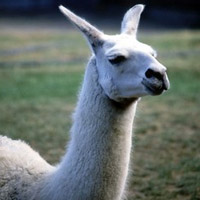Mammals - Llama
 Region:
South America Region:
South America
Class: Mammalia
Order: Artiodactyla
Family: Camelidae
Genus: Lama
Scientific Name: Lama glama
Description: The body has fairly long, dense fine wool.
The hair on the head, neck and limbs is shorter than elsewhere
on its body. Colouration is brown to black or even white,
usually irregularly blotched with these colours. Length
of head and body: 1.2 m Length of tail: 15 cm Height at
shoulder: 1.2 m Weight: 70 - 140 kg
Distribution: Southern and Western South America from
sea level to elevations of 5,000 meters
Habitat: Semi-desert, open country of plateaus and high
pampas
Food: Grasses, shrubs and the leaves and branches of small
trees.
Reproduction and Development: Mate in August and September.
Gestation period is 10 - 11 months. One young is born,
although the female has four teats. Females bear young
every other year unless they abort. Immediately after
birth the young are able to run with surprising endurance.
The youngster is nursed for 6 - 12 weeks. As the young
males develop, they are eventually driven from the herd
by the older females. There is a herd hierarchy with an
alpha female at the top of it. Life expectancy is about
20 years.
Adaptations: In contrast to other animals, the llama’s
hemoglobin has a greater affinity for oxygen and the blood
contains more red corpuscles. This ability partly accounts
for its survival in high altitudes. In the mountains their
safety depends upon their speed (up to 56 km/h) and alertness.
They enjoy standing and even lying in mountain streams
and are said to be good swimmers.
Status: Common
References: Walker, E.P.; Mammals of the World, Johns
Hopkins Press, 5th edition, 1991. http://animaldiversity.ummz.umich.edu/site/accounts/information/Lama_glama.html |
|
|
